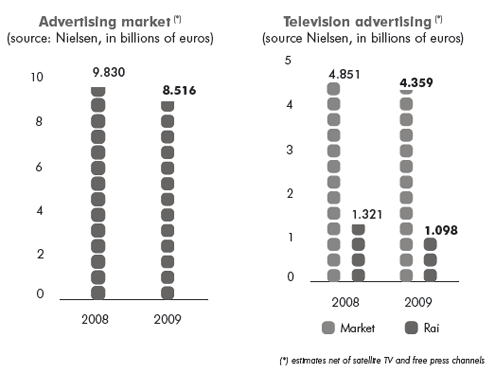|
Sipra
Sipra has an exclusive contract with Rai
to manage the advertising space of
Rai's television and radio broadcasts in
analogue, digital and satellite (both free
and pay), webcasts, with the portal and
all the websites in the www.rai.it
domain, promoting the high value of
the media under concession to
investors, in terms of programming
quality, audience ratings and less
overcrowding.
2009 was another decisive year for
Sipra in the pursuit of the absolute need
for flexibility within its organisational
layout in order to follow and, where
possible, anticipate the increasingly swift
evolutionary changes in the advertising
market.
During the year, Sipra's organisational
structure was adapted to guarantee the
best conditions for promoting Rai's
offering, in a competitive context heavily
conditioned by the impacts linked to the
passage to digital technology.
From February in particular, a complex
review of the commercial structure was
launched, influencing both sales and
marketing.
As regards the sales structure, the main
actions were represented by the
formation of a single unit to monitor the
general-interest and specialised television offering and the creation of a
sales network, aimed at the media
centre channel, for advertising on the
web.
The activities described above
determined the need for a general
review of the agency contracts held with
the sales force, with specific reference to
the customer portfolio and products
assigned. Within the scope of the
commercial support structures, a new
unit was set up for the development of
multimedia offerings and a department
responsible for coordinating commercial
policies.
In keeping with the new strategic lines
for managing film media, the project for
the digitalisation of advertising materials
was launched during the year. The study
and implementation of the project
required the integration of different
skills, as the entire operational process
was fully re-engineered, with impacts on
the commercial, administrative and
technical management structures.
As regards advertising investments, the
negative overall market situation
strongly conditioned buying decisions by
companies and played a decisive role in
reducing advertising budgets: in 2009
the advertising market showed a decline
of �13.4%, with losses of 1.3 billion
euros. Apart from the web, which
showed an increase of +5.1%, almost
all the media suffered two-figure
reductions (source: Nielsen Media
Research � Net investments for 2009).
Television advertising investments highlighted a �10.2% reduction in
2009 and an increase in the market
share from 49.4% to 51.2%. By virtue
of stricter legal limits to overcrowding
by advertising, Rai networks recorded
an overall decline of 16.9%, while
Mediaset reported a reduction of
8.4%.
It is necessary to highlight how the
further decline of Rai's sales figure is
strongly influenced by the structural
differences between Rai products and
those of the main competitor, in terms of
availability of spaces, overcrowding
rules and rating profile, factors which
penalise advertising income on Rai,
especially during periods of financial
difficulty.
In order to properly analyse the
change compared to the previous year,
it is also necessary to consider the
presence in 2008 of the European
Football Championship and
the Beijing Olympics, and of the
General and European Elections
in June 2009.
Sipra gained 137 new television
customers during the year.
In line with the market as a whole, the
Radio division also suffered an overall
decline, falling 7.7% (36.6 million
euros) during the year. Recording a
smaller reduction than that averaged by
the other media, the Radio division's
market share rises from 4.8% to 5.1%.
The FCP estimates on income for the
whole year present a decline by the
media of 8%: in this context, the
commercial radio stations were more
stable than RadioRai, thanks to benefits
from a more competitive cost-percontact
and better profiling on
commercial targets. Despite the marked
decline in investments, RadioRai gained
145 new customers.
The outlook for 2010, in the absence
of elements that allow hopes for a
strong recovery of the economy,
indicate substantial stability of
investments in advertising compared to
2009, also in the presence of the
World Cup in South Africa and the
Winter Olympics. Operators'
expectations agree with the indication
of a first part of the year still
characterised by slight reductions and a
moderate recovery in the autumn.
Continuing on the subject of demand
envisaged in 2010, the European trend
which encourages investors to ask the
media to maintain the number of GRPs
(gross rating points), i.e.: advertising
pressure, despite a drop in investments,
was confirmed. Sipra's commercial
policy in the first part of the year will
be that of a substantial stability in
tariffs, with a trend in line with that of
programmed inflation. The aim is to
defend the value of Rai's television
advertising, which is strongly
threatened by the increase in the
number of competitive players and is
indispensable to the need to guarantee
the resources necessary to the
development of the digitalisation
process.
As regards digitalisation, 2010 will be
an important year for Sipra and Rai.
The progressive expansion of the DTT
platform will implicate a growth in the
ratings of the new Rai channels and a
consequent forecast of growth in
income from advertising.
In terms of the web, the growth aims
can be pursued thanks to the forecast
increase in the number of pages seen
and single users of our portals, as well
as the progressive development of video
content.
Also in terms of film, the digitalisation of
advertising will allow this media, after a
necessary initial trial period, to reduce
the technological gap with the new
media.
As regards radio, 2010 will witness
structural changes to the Audioradio
research which, upon completion of the
experimental phase, will switch to the
dissemination of information based
largely on a panel survey as opposed to
a telephone survey. The results of these
new figures may generate effects,
hopefully positive, from the autumn.
